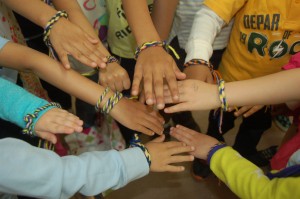Art, Science, and Fun, Intertwined

Originally appears in the Summer 2014 issue
WOULD YOU LIKE A very dynamic, hands-on visual arts project ̶ one that you can use to complement a verbally-saturated lesson about interconnection and cooperation within ecosystems? Would you like to provide young people with an enjoyable activity that makes them more aware of the importance of the work of their focused minds and careful hands, as well as the beauty that can happen when people act in harmony with the principles of nature? If so, read on.
You’ll be showing your youngsters how to make a spiraling bracelet from strands of various coloured yarns ̶ a double reverse twist bracelet. Essentially, you’re teaching them the ancient art of rope making. The bracelets are beautiful, fun to make, and help reinforce the concept of coevolution: when two or more beings reciprocally affect one another’s evolution. This project can also be structured to suggest phenomena ranging from food chains to symbioses simply by changing the meanings attributed to the varied colors of yarn and/or the numbers of strands being employed.
To view the photo-rich magazine version, click here.
If you are not already a subscriber, please subscribe to read the full article
Edith Pucci Couchman is an art and environmental science teacher in southern New Hampshire. She is currently the art teacher for Nashua, NH’s two catholic elementary schools, Infant Jesus School and St. Christopher School, and a summer teacher for Beaver Brook Association in Hollis, NH.
This activity was adapted from Ann Sayre Wiseman’s wonderful classic, Making Things: The Handbook of Creative Discovery, a book that has been inspiring art teachers for over four decades.
Leave a Reply
You must be logged in to post a comment.










